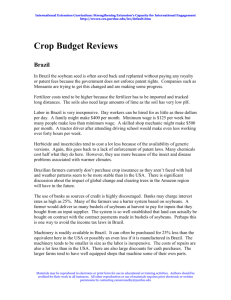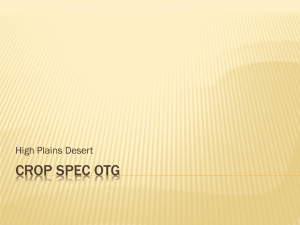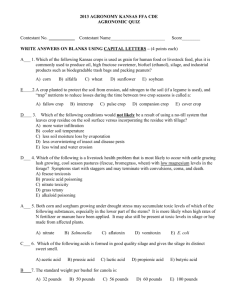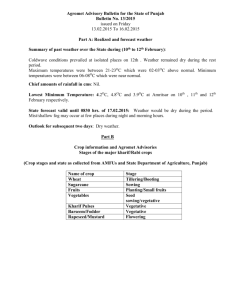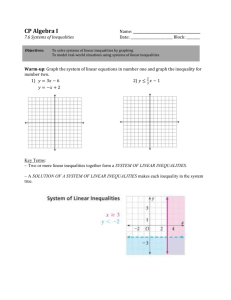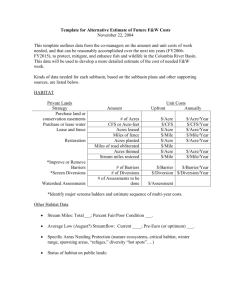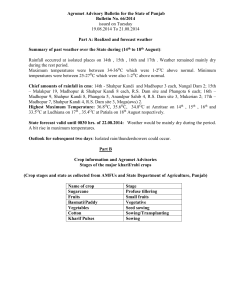2014 Agronomic Quiz Key
advertisement
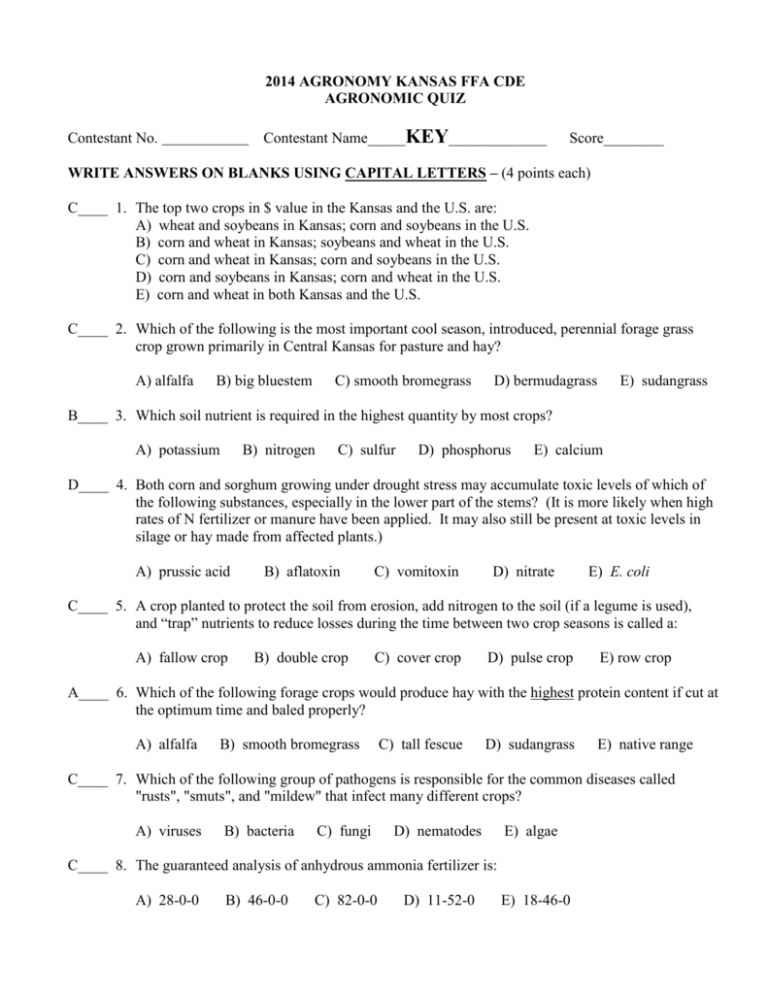
2014 AGRONOMY KANSAS FFA CDE AGRONOMIC QUIZ Contestant Name_____KEY_____________ Contestant No. Score________ WRITE ANSWERS ON BLANKS USING CAPITAL LETTERS – (4 points each) C____ 1. The top two crops in $ value in the Kansas and the U.S. are: A) wheat and soybeans in Kansas; corn and soybeans in the U.S. B) corn and wheat in Kansas; soybeans and wheat in the U.S. C) corn and wheat in Kansas; corn and soybeans in the U.S. D) corn and soybeans in Kansas; corn and wheat in the U.S. E) corn and wheat in both Kansas and the U.S. C____ 2. Which of the following is the most important cool season, introduced, perennial forage grass crop grown primarily in Central Kansas for pasture and hay? A) alfalfa B) big bluestem C) smooth bromegrass D) bermudagrass E) sudangrass B____ 3. Which soil nutrient is required in the highest quantity by most crops? A) potassium B) nitrogen C) sulfur D) phosphorus E) calcium D____ 4. Both corn and sorghum growing under drought stress may accumulate toxic levels of which of the following substances, especially in the lower part of the stems? (It is more likely when high rates of N fertilizer or manure have been applied. It may also still be present at toxic levels in silage or hay made from affected plants.) A) prussic acid B) aflatoxin C) vomitoxin D) nitrate E) E. coli C____ 5. A crop planted to protect the soil from erosion, add nitrogen to the soil (if a legume is used), and “trap” nutrients to reduce losses during the time between two crop seasons is called a: A) fallow crop B) double crop C) cover crop D) pulse crop E) row crop A____ 6. Which of the following forage crops would produce hay with the highest protein content if cut at the optimum time and baled properly? A) alfalfa B) smooth bromegrass C) tall fescue D) sudangrass E) native range C____ 7. Which of the following group of pathogens is responsible for the common diseases called "rusts", "smuts", and "mildew" that infect many different crops? A) viruses B) bacteria C) fungi D) nematodes E) algae C____ 8. The guaranteed analysis of anhydrous ammonia fertilizer is: A) 28-0-0 B) 46-0-0 C) 82-0-0 D) 11-52-0 E) 18-46-0 E____ 9. Weeds like field bindweed are not allowed in any quantity in seed for sale according to state law. These legally regulated weeds are called: A) resistant weeds B) perennial weeds C) common weeds D) annual weeds E) noxious weeds C____ 10. The greatest yield reduction due to drought stress in grain sorghum generally results when stress occurs during the: A) vegetative stage resulting in less tillering B) growing point differentiation stage resulting in fewer heads initiated C) boot stage resulting in poor head emergence D) flowering stage resulting in poor seed set E) grain filling stage resulting in low test weight grain B____ 11. How many seeds are typically in a bag of commercial hybrid corn seed sold in the United States? A) 50,000 B) 80,000 C) 100,000 D) 140,000 E) none of the above, it varies depending upon the seed size D____ 12. Common lambsquarters, pigweed, velvetleaf and cocklebur are problem weeds in Kansas crops. All of them are classified as: A) winter annual broadleaves B) perennial grasses C) summer annual grasses D) summer annual broadleaves E) perennial broadleaves B____ 13. Which of the following factors is NOT required for crop seeds to germinate? A) viable embryo B) fertilizer C) moisture D) oxygen E) suitable temperature D____ 14. The term "scarified seed" when used in alfalfa production refers to: A) seed treated with a fungicide to prevent seedling diseases B) seed treated with a chemical to protect the seedlings from herbicide injury C) seed treated with nitrogen fixing bacteria to insure nitrogen fixation in this legume crop D) seed treated with sandpaper or acid to break the hard seed coat E) scarified seed would have been treated with all of the above D____ 15. Cutting alfalfa at the recommended stage of 1/10 bloom is designed primarily to: A) attain the highest possible hay yield B) attain the highest possible hay quality C) attain both the highest possible hay yield and the highest possible hay quality D) allow enough time for replenishment of carbohydrate reserves in the taproot to insure good regrowth after cutting and long term plant health, with a compromise of yield and quality E) avoid damage from alfalfa weevil, the number one pest of alfalfa in Kansas D____16. Herbicides are officially classified into Groups (ie Group 1, Group 2 … Group 14, etc.) based upon different: A) timing of applicaton (pre-plant, pre-emergence, post-emergence, etc.) B) product formulations (liquid, granule, emulsifiable concentrate, wettable powder, etc.) C) degrees of selectivity on different groups of weeds (broadleaves vs. grasses, small seeded vs. large seeded weeds, etc.) D) sites of action within the weed where the chemical inhibits physiological processes (selecting products from multiple groups will help slow development of weed resistance) E) speed of breakdown in the environment (selecting products from groups with a shorter residual time will help reduce leaching and runoff problems) B____ 17. Applying fertilizer between the rows of a growing corn crop during the vegetative growth stages while also cultivating between the rows for weed control is called: A) fertigation B) sidedressing C) topdressing D) banding E) “dusting it in” E____ 18. Corn rootworms cause damage to corn by: A) feeding on the roots during the larval stage B) feeding on the roots during the adult stage C) feeding on the silks during the adult stage D) feeding on the roots during both the larval stage and the adult stage E) feeding on the roots during the larval stage and feeding on the silks during the adult stage D____ 19. A herbicide like "Roundup" that is taken up and translocated throughout the plant is called: A) selective B) non-selective C) contact D) systemic E) residual C____ 20. Which of the following tillage tools would incorporate the greatest amount of crop residue? A) field cultivator B) tandem disk C) moldboard plow D) rotary hoe E) all of the above would be about equal in amount of residue incorporated E____ 21.Which of the following conditions would likely be a result of using a no-till system that leaves crop residue on the soil surface versus incorporating the residue with tillage? A) more overwintering of insect and disease pests B) cooler soil temperature C) more water infiltration D) less soil moisture evaporation E) all of the above are likely results of no-till systems compared to tillage systems B____ 22. Which of the following is an advantage of sprinkler irrigation over furrow irrigation systems? A) less evaporation loss with sprinkler B) more uniform application of water with sprinkler C) less energy required to pump and distribute water with sprinkler D) lower equipment maintenance costs with sprinkler E) all of the above are advantages of sprinkler over furrow irrigation systems B____ 23. The terms effective calcium carbonate equivalent and fineness factor would be used to measure the quality of: A) cotton fibers B) agricultural lime C) spray adjuvants D) gypsum E) soybean meal C____ 24. If a hail storm damages V2 soybeans, the most likely result will be: A) No regrowth if the stems are cut below the first trifoliolate leaf node B) No regrowth if the stems are cut below the unifoliolate leaf node C) No regrowth if the stems are cut below the cotyledonary node D) No regrowth no matter where the stems are cut - any damage before V3 will kill the plants E) Full regrowth no matter where the stems are cut - growing point is still below the soil at V2 C____ 25. What does the term “dusting in” refer to in wheat production? A) planting wheat with a dry starter fertilizer banded near the seed B) planting wheat treated with a dry formulation of fungicide C) planting wheat shallow into a dry surface layer D) planting wheat deep into moisture below a dry surface layer E) it has nothing to do with planting wheat, but rather with getting wheat harvested before it rains B____ 26. A common virus disease of wheat is barley yellow dwarf mosaic. The most common vector for this disease pathogen is: A) wind B) aphids C) rootworms D) wheat curl mites E) a fungus D____ 27. In the custom blended fertilizer 9-18-9, the “18” represents: A) percentage of nitrogen in the fertilizer B) percentage of potassium in the fertilizer C) percentage of phosphorus in the fertilizer D) percentage of P2O5 in the fertilizer E) percentage of K2O in the fertilizer D____ 28. A new transgenic trait for soybeans and corn already being heavily advertised under the trade name “Enlist” is expected to be released next year by Dow AgroSciences. The “Enlist” trait is intended to make crops: A. drought tolerant B. resistant to most major fungal diseases C. able to fix nitrogen like legumes D. resistant to the growth regulator herbicide 2,4-D E. resistant to mites and nematodes, an important development since these two pests are different from insects and do not have as many chemical control options as for insects A____ 29. Conversion of soil nitrate to nitrogen gases that can then be lost from the soil, which is most likely on waterlogged or poorly drained soils, is called: A) denitrification B) immobilization C) nitrogen fixation D) leaching E) none of the above, soil nitrate cannot be converted to gaseous forms B____ 30. Runoff of excess amounts of nutrients (primarily nitrogen and phosphorus) into lakes may result in excess algae growth, followed by decomposition of the algae and depletion of oxygen in the water, leading to the death of fish and other aquatic organisms. This process is called: A) carbon sequestration B) eutrophication C) point source pollution D) leaching E) global warming AGRONOMIC CALCULATIONS Two part questions are 6 points each. One part questions are 4 points each. To receive full credit, show calculations and place answer in the box. Round to the nearest tenth unless otherwise indicated. Useful conversions: 43,560 ft2/acre, 2,000 lb/ton, 12 inches/foot, 5280 ft/mile, 3785 ml per gallon. 31. A crop consultant is calibrating an air seeder for soybeans. He finds an average of 82 seeds dropped per 25 foot of row by one planter unit. The machine has 15-inch row spacing. What is the seeding rate in seeds per acre? 114,300 seeds/acre 82 seeds/(25 ft x 15/12 ft) x 43,460 ft2/acre = 32. Your soil test recommends 75 pounds N per acre and 55 pounds P2O5 per acre for grain sorghum. Fertilizers available are UAN (32-0-0) at $380/ton and DAP (18-46-0) at $550/ton. a. How many pounds of DAP is needed per acre? (55 # P2O5/acre)/0.46 = 119.6 # DAP/acre b. What is the total fertilizer cost per acre? 119.6 # DAP x 0.18 = 21.5 # N with DAP 75 – 21.5 = 53.5 # N/acre remaining need 53.5/0.32 = 167.2 # UAN needed $ 64.66 / acr 167.2 # UAN/acre x $380/2000 # UAN = $31.77/acre for UAN 119.6 # DAP/acre x $550/2000 # DAP = $32.89/acre for DAP 33. A grass seed bag is labelled: Germination = 85% What is the % Pure Live Seed (PLS)? 0.85 germ x 0.90 purity = 0.765 PLS Weed Seed = 5% 76.5 % PLS Inert Matter = 5% 34. Prior to harvest, a farmer wants to estimate the yield for her soybean crop. Random counts in the field result in an average of 6 soybean plants per square foot with an average of 36 seeds per plant. Assume a seed weight of 3000 seeds per pound. Estimate the yield in bushels per acre using the standard weight per bushel for soybeans. 52.3 bushels/acre 6 plants/sq ft x 43,560 sq ft/acre x 36 seeds/plant x pound/3000 seeds x bushel/60 pounds = 35. You are calibrating a sprayer and you collect 332 ml of water in 15 seconds from an individual nozzle. Nozzle spacing is 20 inches and the speed of travel is 6 miles per hour. a. What is the nozzle delivery rate in gallons per minute? 0.4 GPM (rounded from 0.35) b. What is the application rate in gallons per acre? (you may use the shortcut formula) 19.8 GPA (17.3 if use 0.35 GPM) GPA = 5940 x GPM MPH x Nozzle Spacing in Inches 5940 x 0.4 6 x 20 36. A farmer wants to spray Bug-Off 75 WDG (75% a.i. water dispersible granules) insecticide. He has a 400 gal spray tank calibrated to spray at 20 gallons per acre (GPA). a. If the label recommends 3 pounds Bug-Off per acre, how much should be added to one tankful? 60 # BugOff/tank 400 gal/tank x acre/20 gal = 20 acre/tank 20 acre/tank x 3 # bugoff/acre = 60 # bugoff/tank b. If the Bug-Off costs $15 for a 10-pound bag, what is the cost per pound of active ingredient? 10#/bag x 0.75 ai = 7.5 # ai/bag $15/bag x bag/7.5# ai = $2/#ai $2.00 / pound ai
